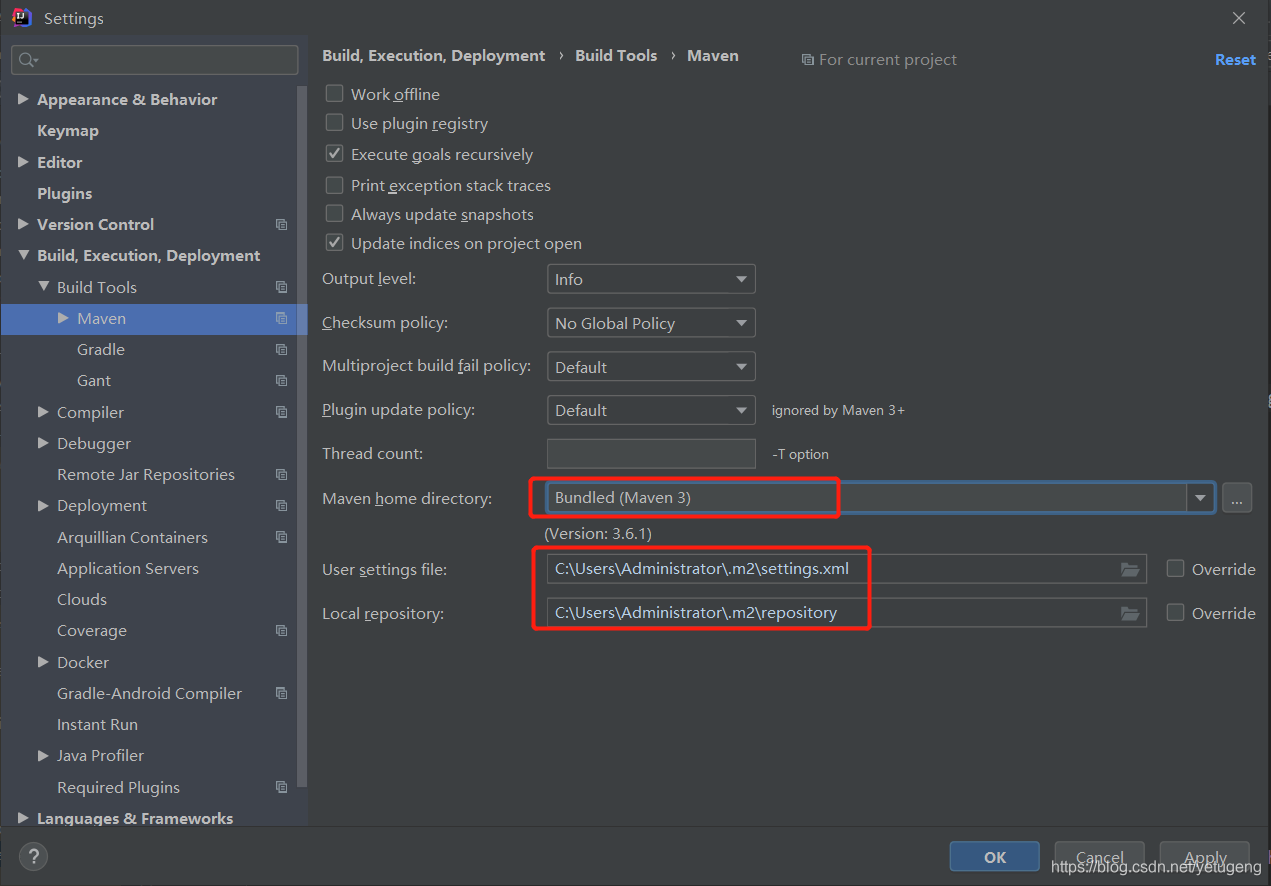Maven项目对象模型(POM-Project Object Model),可以通过一小段描述信息来管理项目的构建,报告和文档的项目管理工具软件。
软件版本:
IntelliJ IDEA 2019.2.4 (Ultimate Edition)
apache-maven-3.6.3-bin.zip
IDEA 内置的 Maven:
在IDEA中,maven的默认配置是如下图

Maven home directory :maven的家目录,可以选择IDEA自带的版本,亦或是选择我们自己下载的版本(解压后的目录)。
User settings file :用户配置文件,默认是 C:\Users\Administrator\.m2\settings.xml
Local repository :本地源目录,默认是 C:\Users\Administrator\.m2\repository
此外,我们在项目下,还会编辑一个pom.xml配置文件。

系统安装的 Maven:
也可以到maven官网下载安装
https://maven.apache.org/download.cgi
解压后的文件内容如下

还需要配置系统环境变量
M2_HOME=E:\Software\java_software\apache-maven\apache-maven-3.6.3
还需要在 “Path” 环境变量里添加 Mavin的bin目录,即
%M2_HOME%\bin
在cmd下输入mvn -v ,能正确显示版本号就安装好了。

现在我们再来看看系统版本的maven的配置文件目录

settings.xml文件是干什么的,为什么要配置它呢?
从settings.xml的文件名就可以看出,它是用来设置maven参数的配置文件。并且,settings.xml是maven的全局配置文件。而pom.xml文件是所在项目的局部配置。
Settings.xml中包含类似本地仓储位置、修改远程仓储服务器、认证信息等配置。
settings.xml文件位置
settings.xml文件一般存在于两个位置:
全局配置: ${M2_HOME}/conf/settings.xml
用户配置: ${user.home}/.m2/settings.xml
note:用户配置优先于全局配置。${user.home} 和和所有其他系统属性只能在3.0+版本上使用。请注意windows和Linux使用变量的区别。
配置优先级
需要注意的是:局部配置优先于全局配置。
配置优先级从高到低:pom.xml> user settings > global settings
如果这些文件同时存在,在应用配置时,会合并它们的内容,如果有重复的配置,优先级高的配置会覆盖优先级低的。
主配置文件 settings.xml
默认情况下,settings.xml 里面的内容都是注释掉的,下面我们来详细看看这个配置文件。
settings.xml 的内容主要分为以下几部分标签:
- settings
- localRepository
- interactiveMode
- offline
- pluginGroups
- proxies
- servers
- mirrors
- profiles
- activeProfiles
下面是去掉掉注释后的配置文件内容:
<settings xmlns="http://maven.apache.org/SETTINGS/1.0.0"
xmlns:xsi="http://www.w3.org/2001/XMLSchema-instance"
xsi:schemaLocation="http://maven.apache.org/SETTINGS/1.0.0 http://maven.apache.org/xsd/settings-1.0.0.xsd">
<localRepository>/path/to/local/repo</localRepository>
<interactiveMode>true</interactiveMode>
<offline>false</offline>
<pluginGroups>
<pluginGroup>com.your.plugins</pluginGroup>
</pluginGroups>
<proxies>
<proxy>
<id>optional</id>
<active>true</active>
<protocol>http</protocol>
<username>proxyuser</username>
<password>proxypass</password>
<host>proxy.host.net</host>
<port>80</port>
<nonProxyHosts>local.net|some.host.com</nonProxyHosts>
</proxy>
</proxies>
<servers>
<server>
<id>deploymentRepo</id>
<username>repouser</username>
<password>repopwd</password>
</server>
<server>
<id>siteServer</id>
<privateKey>/path/to/private/key</privateKey>
<passphrase>optional; leave empty if not used.</passphrase>
</server>
</servers>
<mirrors>
<mirror>
<id>mirrorId</id>
<mirrorOf>repositoryId</mirrorOf>
<name>Human Readable Name for this Mirror.</name>
<url>http://my.repository.com/repo/path</url>
</mirror>
<mirror>
<id>localMaven</id>
<mirrorOf>*</mirrorOf>
<name>MyMaven</name>
<url>http://maven.aliyun.com/nexus/content/groups/public</url>
</mirror>
</mirrors>
<profiles>
<profile>
<id>jdk-1.4</id>
<activation>
<jdk>1.4</jdk>
</activation>
<repositories>
<repository>
<id>jdk14</id>
<name>Repository for JDK 1.4 builds</name>
<url>http://www.myhost.com/maven/jdk14</url>
<layout>default</layout>
<snapshotPolicy>always</snapshotPolicy>
</repository>
</repositories>
</profile>
<profile>
<id>env-dev</id>
<activation>
<property>
<name>target-env</name>
<value>dev</value>
</property>
</activation>
<properties>
<tomcatPath>/path/to/tomcat/instance</tomcatPath>
</properties>
</profile>
</profiles>
<activeProfiles>
<activeProfile>alwaysActiveProfile</activeProfile>
<activeProfile>anotherAlwaysActiveProfile</activeProfile>
</activeProfiles>
</settings>
1 LocalRepository
作用:表示构建系统的本地仓库
默认值 :${user.home}/.m2/repository
2 InteractiveMode
作用:表示maven是否需要和用户交互以获得输入。
如果maven需要和用户交互以获得输入,则设置成true,反之则应为false。
默认值:<interactiveMode>true</interactiveMode>
3 Offline
作用:表示maven是否需要在离线模式下运行。
如果构建系统需要在离线模式下运行,则为true。
当由于网络设置原因或者安全因素,构建服务器不能连接远程仓库的时候,该配置就十分有用。
默认值:<offline>false</offline>
4 PluginGroups
作用:当插件的组织id(groupId)没有显式提供时,供搜寻插件组织Id(groupId)的列表。
该元素包含一个pluginGroup元素列表,每个子元素包含了一个组织Id(groupId)。
当我们使用某个插件,并且没有在命令行为其提供组织Id(groupId)的时候,Maven就会使用该列表。默认情况下该列表包含了org.apache.maven.plugins和org.codehaus.mojo。
<settings xmlns="http://maven.apache.org/SETTINGS/1.0.0" xmlns:xsi="http://www.w3.org/2001/XMLSchema-instance"
xsi:schemaLocation="http://maven.apache.org/SETTINGS/1.0.0
https://maven.apache.org/xsd/settings-1.0.0.xsd">
...
<pluginGroups>
<!--plugin的组织Id(groupId) -->
<pluginGroup>org.codehaus.mojo</pluginGroup>
</pluginGroups>
...
</settings>
5 Proxies
作用:用来配置不同的代理。
<settings xmlns="http://maven.apache.org/SETTINGS/1.0.0" xmlns:xsi="http://www.w3.org/2001/XMLSchema-instance"
xsi:schemaLocation="http://maven.apache.org/SETTINGS/1.0.0
https://maven.apache.org/xsd/settings-1.0.0.xsd">
...
<proxies>
<!--代理元素包含配置代理时需要的信息 -->
<proxy>
<!--代理的唯一定义符,用来区分不同的代理元素。 -->
<id>myproxy</id>
<!--该代理是否是激活的那个。true则激活代理。当我们声明了一组代理,而某个时候只需要激活一个代理的时候,该元素就可以派上用处。 -->
<active>true</active>
<!--代理的协议。 协议://主机名:端口,分隔成离散的元素以方便配置。 -->
<protocol>http</protocol>
<!--代理的主机名。协议://主机名:端口,分隔成离散的元素以方便配置。 -->
<host>proxy.somewhere.com</host>
<!--代理的端口。协议://主机名:端口,分隔成离散的元素以方便配置。 -->
<port>8080</port>
<!--代理的用户名,用户名和密码表示代理服务器认证的登录名和密码。 -->
<username>proxyuser</username>
<!--代理的密码,用户名和密码表示代理服务器认证的登录名和密码。 -->
<password>somepassword</password>
<!--不该被代理的主机名列表。该列表的分隔符由代理服务器指定;例子中使用了竖线分隔符,使用逗号分隔也很常见。 -->
<nonProxyHosts>*.google.com|ibiblio.org</nonProxyHosts>
</proxy>
</proxies>
...
</settings>
6 Servers
作用:一般,仓库的下载和部署是在pom.xml文件中的repositories和distributionManagement元素中定义的。然而,一般类似用户名、密码(有些仓库访问是需要安全认证的)等信息不应该在pom.xml文件中配置,这些信息可以配置在settings.xml中。
<settings xmlns="http://maven.apache.org/SETTINGS/1.0.0" xmlns:xsi="http://www.w3.org/2001/XMLSchema-instance"
xsi:schemaLocation="http://maven.apache.org/SETTINGS/1.0.0
https://maven.apache.org/xsd/settings-1.0.0.xsd">
...
<!--配置服务端的一些设置。一些设置如安全证书不应该和pom.xml一起分发。这种类型的信息应该存在于构建服务器上的settings.xml文件中。 -->
<servers>
<!--服务器元素包含配置服务器时需要的信息 -->
<server>
<!--这是server的id(注意不是用户登陆的id),该id与distributionManagement中repository元素的id相匹配。 -->
<id>server001</id>
<!--鉴权用户名。鉴权用户名和鉴权密码表示服务器认证所需要的登录名和密码。 -->
<username>my_login</username>
<!--鉴权密码 。鉴权用户名和鉴权密码表示服务器认证所需要的登录名和密码。密码加密功能已被添加到2.1.0 +。详情请访问密码加密页面 -->
<password>my_password</password>
<!--鉴权时使用的私钥位置。和前两个元素类似,私钥位置和私钥密码指定了一个私钥的路径(默认是${user.home}/.ssh/id_dsa)以及如果需要的话,一个密语。将来passphrase和password元素可能会被提取到外部,但目前它们必须在settings.xml文件以纯文本的形式声明。 -->
<privateKey>${usr.home}/.ssh/id_dsa</privateKey>
<!--鉴权时使用的私钥密码。 -->
<passphrase>some_passphrase</passphrase>
<!--文件被创建时的权限。如果在部署的时候会创建一个仓库文件或者目录,这时候就可以使用权限(permission)。这两个元素合法的值是一个三位数字,其对应了unix文件系统的权限,如664,或者775。 -->
<filePermissions>664</filePermissions>
<!--目录被创建时的权限。 -->
<directoryPermissions>775</directoryPermissions>
</server>
</servers>
...
</settings>
7 Mirrors
作用:为仓库列表配置的下载镜像列表。
<settings xmlns="http://maven.apache.org/SETTINGS/1.0.0" xmlns:xsi="http://www.w3.org/2001/XMLSchema-instance"
xsi:schemaLocation="http://maven.apache.org/SETTINGS/1.0.0
https://maven.apache.org/xsd/settings-1.0.0.xsd">
...
<mirrors>
<!-- 给定仓库的下载镜像。 -->
<mirror>
<!-- 该镜像的唯一标识符。id用来区分不同的mirror元素。 -->
<id>planetmirror.com</id>
<!-- 镜像名称 -->
<name>PlanetMirror Australia</name>
<!-- 该镜像的URL。构建系统会优先考虑使用该URL,而非使用默认的服务器URL。 -->
<url>http://downloads.planetmirror.com/pub/maven2</url>
<!-- 被镜像的服务器的id。例如,如果我们要设置了一个Maven中央仓库(http://repo.maven.apache.org/maven2/)的镜像,就需要将该元素设置成central。这必须和中央仓库的id central完全一致。 -->
<mirrorOf>central</mirrorOf>
</mirror>
</mirrors>
...
</settings>
8 Profiles
作用:根据环境参数来调整构建配置的列表。
settings.xml中的profile元素是pom.xml中profile元素的裁剪版本。
它包含了id、activation、repositories、pluginRepositories和 properties元素。这里的profile元素只包含这五个子元素是因为这里只关心构建系统这个整体(这正是settings.xml文件的角色定位),而非单独的项目对象模型设置。如果一个settings.xml中的profile被激活,它的值会覆盖任何其它定义在pom.xml中带有相同id的profile。
<settings xmlns="http://maven.apache.org/SETTINGS/1.0.0" xmlns:xsi="http://www.w3.org/2001/XMLSchema-instance"
xsi:schemaLocation="http://maven.apache.org/SETTINGS/1.0.0
https://maven.apache.org/xsd/settings-1.0.0.xsd">
...
<profiles>
<profile>
<!-- profile的唯一标识 -->
<id>test</id>
<!-- 自动触发profile的条件逻辑 -->
<activation />
<!-- 扩展属性列表 -->
<properties />
<!-- 远程仓库列表 -->
<repositories />
<!-- 插件仓库列表 -->
<pluginRepositories />
</profile>
</profiles>
...
</settings>
8.1 Activation
作用:自动触发profile的条件逻辑。
如pom.xml中的profile一样,profile的作用在于它能够在某些特定的环境中自动使用某些特定的值;这些环境通过activation元素指定。activation元素并不是激活profile的唯一方式。settings.xml文件中的activeProfile元素可以包含profile的id。profile也可以通过在命令行,使用-P标记和逗号分隔的列表来显式的激活(如,-P test)。
<activation>
<!--profile默认是否激活的标识 -->
<activeByDefault>false</activeByDefault>
<!--当匹配的jdk被检测到,profile被激活。例如,1.4激活JDK1.4,1.4.0_2,而!1.4激活所有版本不是以1.4开头的JDK。 -->
<jdk>1.5</jdk>
<!--当匹配的操作系统属性被检测到,profile被激活。os元素可以定义一些操作系统相关的属性。 -->
<os>
<!--激活profile的操作系统的名字 -->
<name>Windows XP</name>
<!--激活profile的操作系统所属家族(如 'windows') -->
<family>Windows</family>
<!--激活profile的操作系统体系结构 -->
<arch>x86</arch>
<!--激活profile的操作系统版本 -->
<version>5.1.2600</version>
</os>
<!--如果Maven检测到某一个属性(其值可以在POM中通过${name}引用),其拥有对应的name = 值,Profile就会被激活。如果值字段是空的,那么存在属性名称字段就会激活profile,否则按区分大小写方式匹配属性值字段 -->
<property>
<!--激活profile的属性的名称 -->
<name>mavenVersion</name>
<!--激活profile的属性的值 -->
<value>2.0.3</value>
</property>
<!--提供一个文件名,通过检测该文件的存在或不存在来激活profile。missing检查文件是否存在,如果不存在则激活profile。另一方面,exists则会检查文件是否存在,如果存在则激活profile。 -->
<file>
<!--如果指定的文件存在,则激活profile。 -->
<exists>${basedir}/file2.properties</exists>
<!--如果指定的文件不存在,则激活profile。 -->
<missing>${basedir}/file1.properties</missing>
</file>
</activation>
注:在maven工程的pom.xml所在目录下执行mvn help:active-profiles命令可以查看中央仓储的profile是否在工程中生效。
8.2 properties
作用:对应profile的扩展属性列表。
maven属性和ant中的属性一样,可以用来存放一些值。这些值可以在pom.xml中的任何地方使用标记${X}来使用,这里X是指属性的名称。属性有五种不同的形式,并且都能在settings.xml文件中访问。
1. env.X: 在一个变量前加上"env."的前缀,会返回一个shell环境变量。例如,"env.PATH"指代了$path环境变量(在Windows上是%PATH%)。
2. project.x:指代了POM中对应的元素值。例如: <project><version>1.0</version></project>通过${project.version}获得version的值。
3. settings.x: 指代了settings.xml中对应元素的值。例如:<settings><offline>false</offline></settings>通过 ${settings.offline}获得offline的值。
4. Java System Properties: 所有可通过java.lang.System.getProperties()访问的属性都能在POM中使用该形式访问,例如 ${java.home}。
5. x: 在<properties/>元素中,或者外部文件中设置,以${someVar}的形式使用。
<properties>
<user.install>${user.home}/our-project</user.install>
</properties>
注:如果该profile被激活,则可以在pom.xml中使用${user.install}。
8.3 Repositories
作用:远程仓库列表,它是maven用来填充构建系统本地仓库所使用的一组远程仓库。
<repositories>
<!--包含需要连接到远程仓库的信息 -->
<repository>
<!--远程仓库唯一标识 -->
<id>codehausSnapshots</id>
<!--远程仓库名称 -->
<name>Codehaus Snapshots</name>
<!--如何处理远程仓库里发布版本的下载 -->
<releases>
<!--true或者false表示该仓库是否为下载某种类型构件(发布版,快照版)开启。 -->
<enabled>false</enabled>
<!--该元素指定更新发生的频率。Maven会比较本地POM和远程POM的时间戳。这里的选项是:always(一直),daily(默认,每日),interval:X(这里X是以分钟为单位的时间间隔),或者never(从不)。 -->
<updatePolicy>always</updatePolicy>
<!--当Maven验证构件校验文件失败时该怎么做-ignore(忽略),fail(失败),或者warn(警告)。 -->
<checksumPolicy>warn</checksumPolicy>
</releases>
<!--如何处理远程仓库里快照版本的下载。有了releases和snapshots这两组配置,POM就可以在每个单独的仓库中,为每种类型的构件采取不同的策略。例如,可能有人会决定只为开发目的开启对快照版本下载的支持。参见repositories/repository/releases元素 -->
<snapshots>
<enabled />
<updatePolicy />
<checksumPolicy />
</snapshots>
<!--远程仓库URL,按protocol://hostname/path形式 -->
<url>http://snapshots.maven.codehaus.org/maven2</url>
<!--用于定位和排序构件的仓库布局类型-可以是default(默认)或者legacy(遗留)。Maven 2为其仓库提供了一个默认的布局;然而,Maven 1.x有一种不同的布局。我们可以使用该元素指定布局是default(默认)还是legacy(遗留)。 -->
<layout>default</layout>
</repository>
</repositories>
9 ActiveProfiles
作用:手动激活profiles的列表,按照profile被应用的顺序定义activeProfile。
该元素包含了一组activeProfile元素,每个activeProfile都含有一个profile id。任何在activeProfile中定义的profile id,不论环境设置如何,其对应的 profile都会被激活。如果没有匹配的profile,则什么都不会发生。
例如,env-test是一个activeProfile,则在pom.xml(或者profile.xml)中对应id的profile会被激活。如果运行过程中找不到这样一个profile,Maven则会像往常一样运行。
<settings xmlns="http://maven.apache.org/SETTINGS/1.0.0" xmlns:xsi="http://www.w3.org/2001/XMLSchema-instance"
xsi:schemaLocation="http://maven.apache.org/SETTINGS/1.0.0
https://maven.apache.org/xsd/settings-1.0.0.xsd">
...
<activeProfiles>
<!-- 要激活的profile id -->
<activeProfile>env-test</activeProfile>
</activeProfiles>
...
</settings>
参考
https://www.cnblogs.com/dirgo/p/11433157.html
https://www.cnblogs.com/soupk/p/9303611.html
https://www.cnblogs.com/sxdcgaq8080/p/5588070.html
https://www.cnblogs.com/jingmoxukong/p/6050172.html?utm_source=gold_browser_extension
来源:CSDN
作者:庚庚911
链接:https://blog.csdn.net/yetugeng/article/details/104776191